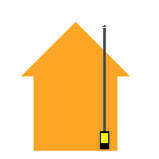Stoves for Airtight Houses

New-build houses are becoming increasingly well-insulated and therefore more air tight. This is particularly relevant when it comes to installing a woodburning stove or solid fuel stove into an airtight or passiv house.
Here are some examples of standards used in building highly insulated airtight homes. Buildings which meet these standards will be warm in winter, cool in summer, and be cheaper to run.
The Passiv Haus
Passiv Haus is a German standard relating to the energy consumption of the building. Passiv Haus (or Passive House) is often used as a wide term to describe low energy buildings, but that is really an inappropriate use of the term. To be a Passiv Haus, strict criteria must be met regarding energy performance.
Carbonlite
AECB's Carbonlite standard - they are a sort of UK passiv haus equivalent. The standards are expressed in terms of energy use and CO2 emissions per square metre and year - measured in kWh and tonnes respectively.
How do these air tight homes effect stoves and flues?
Stove sizing
One of the main differences between a low energy or passiv house and a 'normal' house is the heat needed. A highly insulated low energy home may only need 1-3kW of heating when its really cold.
This of course will depend on the size of the building, location, aspect etc. For visual impact a larger looking wood burning stove may be required, but the kw output will need to be low. If you have a 10kW solid fuel stove, and you only put 2kW worth of wood in it, you will only get 2kW out. It is however better to have a smaller stove burning harder, than a high kw output stove that you have to 'slow burn'. What can be an ideal solution is a wood boiler stove where most of the heat goes to a thermal store and only a little to the room. We design lots of installations and heating systems like this and we'd love to get involved and help with your project.
Combustion air
Another consideration is the ventilation requirement for the woodburning stove. Building Regs stipulate that 'Combustion appliances shall be so installed that there is an adequate supply of air to them for combustion, to prevent overheating and for the efficient working of any flue' - Requirements J1, Approved Document J.
In an airtight/well sealed house there isn't a supply of air available to the room. This means that instead of the solid fuel stove drawing the combustion air from the room, it ideally needs to have an air supply duct drawing fresh air from the outside connected to the body of the stove itself. (The alternative would be making a permanent hole/vent in wall to supply this air, thus puncturing the house's airtightness). Not all stoves have this option; here is a list of stoves that take a direct air supply
You may wish to talk to us about whether you need a woodburning stove which requires a partial or total direct air supply. If it is a very air tight house, or even an extension to an existing house, built to passive house standard or similar, look at total direct air stoves. For Passiv Haus homes a DIBt stove may be required.
MVHR
Mechanical Ventilation Heat Recovery (MVHR) is very often used in new build houses. This essentially involves mechanically blowing air into the house through heat exchangers. This means that you can slightly over-pressurise the stove room, so that when you open the door of the stove to reload, you should not get smoke coming into the room. A MVHR system may, for example, supply 12000mm2 of vent free area into the stove room. This would in theory be enough to supply a 21kW stove with all its entire combustion air requirement.
To use a stove in a property with MVHR, there must not be a negative pressure in the room that the stove is to be installed. A stove with total direct air must be installed; these stoves take all of the air required for combustion from the outside. We do however recommend consulting the HETAS installer or local building inspector to confirm that they are happy to certify the installation before placing an order.
Pressure Testing
Airtight buildings very often have to have a pressure test. In other European countries they tend to complete the pressure test, and then install the stove and flue. Sometimes Building Control insists the wood stove and flue are in place before the pressure test is carried out. This should involve blocking off all 'holes' in the skin of the building, including the direct air supply duct to the woodburning stove and the flue. Sometimes the flue is not blocked off for the test; this means you will get very small leakage of air through the appliance and twin wall flue joints (even total air-sealed stoves will leak a tiny amount of air). This is not regarded as a problem by any of the designers and architects we have spoken to.
HETAS Risk Assessment and BS8303 allows for a stove to be installed without a permanent vent to the room
Although Document J of the building regs does recommend a 'non-closable' room vent in the wall as well as the direct air supply to the stove BS8303 now details a method by which you can see if the stove works well without this permanent vent to the room. Essentially it boils down to smoke testing the stove with the door open, all extraction units turned on, all windows and door closed. If once the risk assessment procedure has been carried out and the stove does not smoke into the room then it is deemed to pass. Its a bit more complicated than that, but your HETAS installer has access to the full procedure.
If the stove does smoke into the room then simply install one of our AirSmart devices which open a vent to the room only when the door of the stove is opened. You can choose a standalone model or a fully automated controller which will also adjust the burn rate of your stove and shut it down if its getting too hot.
So, after all that, what is the conclusion?
It is now not only possible, but legal to install a stove with a direct air supply but no vent to the room - as long as your installer follows the procedure.



